lock BMW 528I SEDAN 2011 User Guide
[x] Cancel search | Manufacturer: BMW, Model Year: 2011, Model line: 528I SEDAN, Model: BMW 528I SEDAN 2011Pages: 304, PDF Size: 10.18 MB
Page 35 of 304
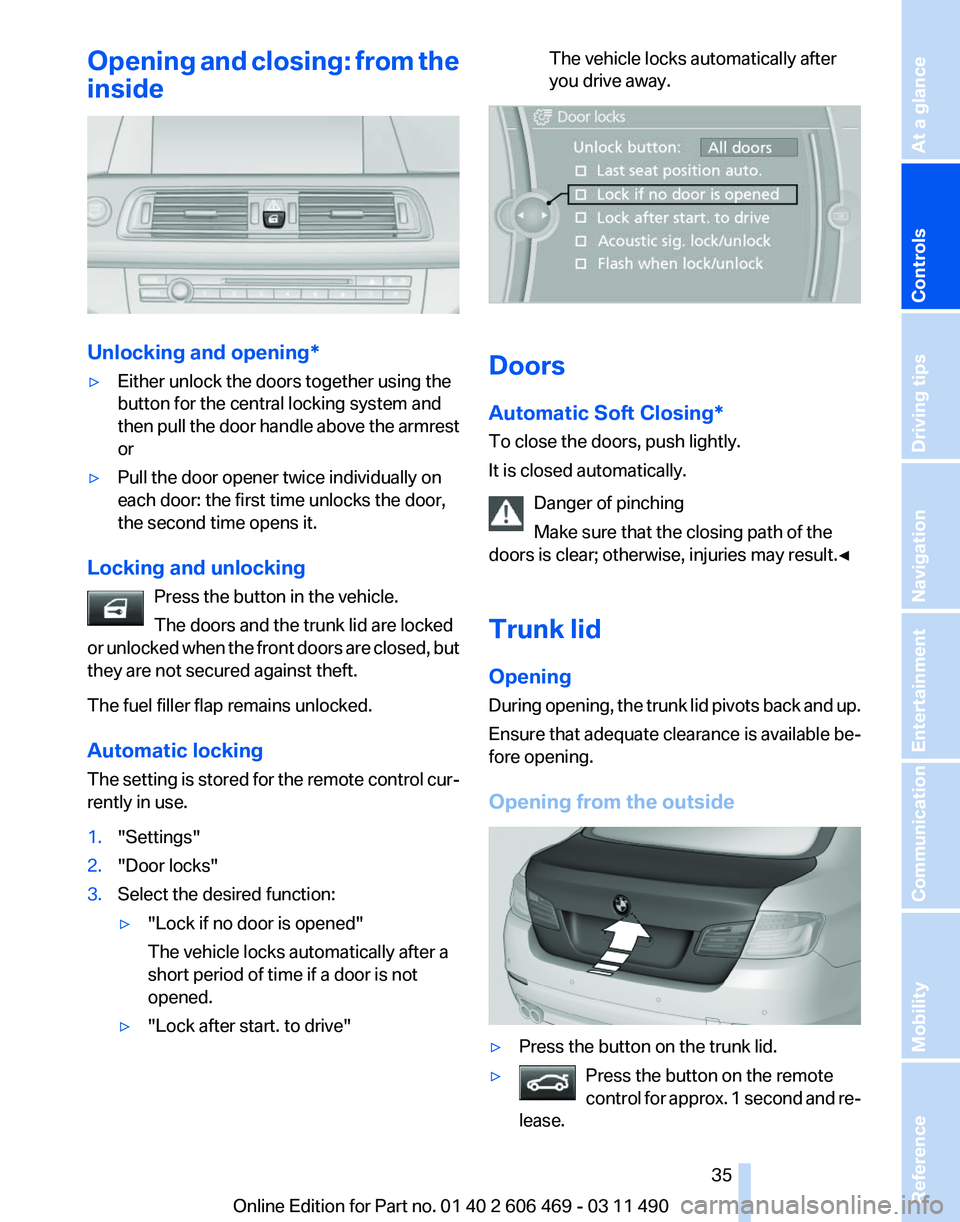
Opening and closing: from the
inside
Unlocking and opening*
‚ñ∑
Either unlock the doors together using the
button for the central locking system and
then
pull the door handle above the armrest
or
‚ñ∑ Pull the door opener twice individually on
each door: the first time unlocks the door,
the second time opens it.
Locking and unlocking Press the button in the vehicle.
The doors and the trunk lid are locked
or
unlocked when the front doors are closed, but
they are not secured against theft.
The fuel filler flap remains unlocked.
Automatic locking
The setting is stored for the remote control cur‚Äê
rently in use.
1. "Settings"
2. "Door locks"
3. Select the desired function:
‚ñ∑"Lock if no door is opened"
The vehicle locks automatically after a
short period of time if a door is not
opened.
‚ñ∑ "Lock after start. to drive" The vehicle locks automatically after
you drive away.
Doors
Automatic Soft Closing*
To close the doors, push lightly.
It is closed automatically.
Danger of pinching
Make sure that the closing path of the
doors is clear; otherwise, injuries may result.‚óÄ
Trunk lid
Opening
During
opening, the trunk lid pivots back and up.
Ensure that adequate clearance is available be‚Äê
fore opening.
Opening from the outside ‚ñ∑
Press the button on the trunk lid.
‚ñ∑ Press the button on the remote
control
for approx. 1 second and re‚Äê
lease. Seite 35
35Online Edition for Part no. 01 40 2 606 469 - 03 11 490
Reference Mobility Communication Entertainment Navigation Driving tips
Controls At a glance
Page 36 of 304
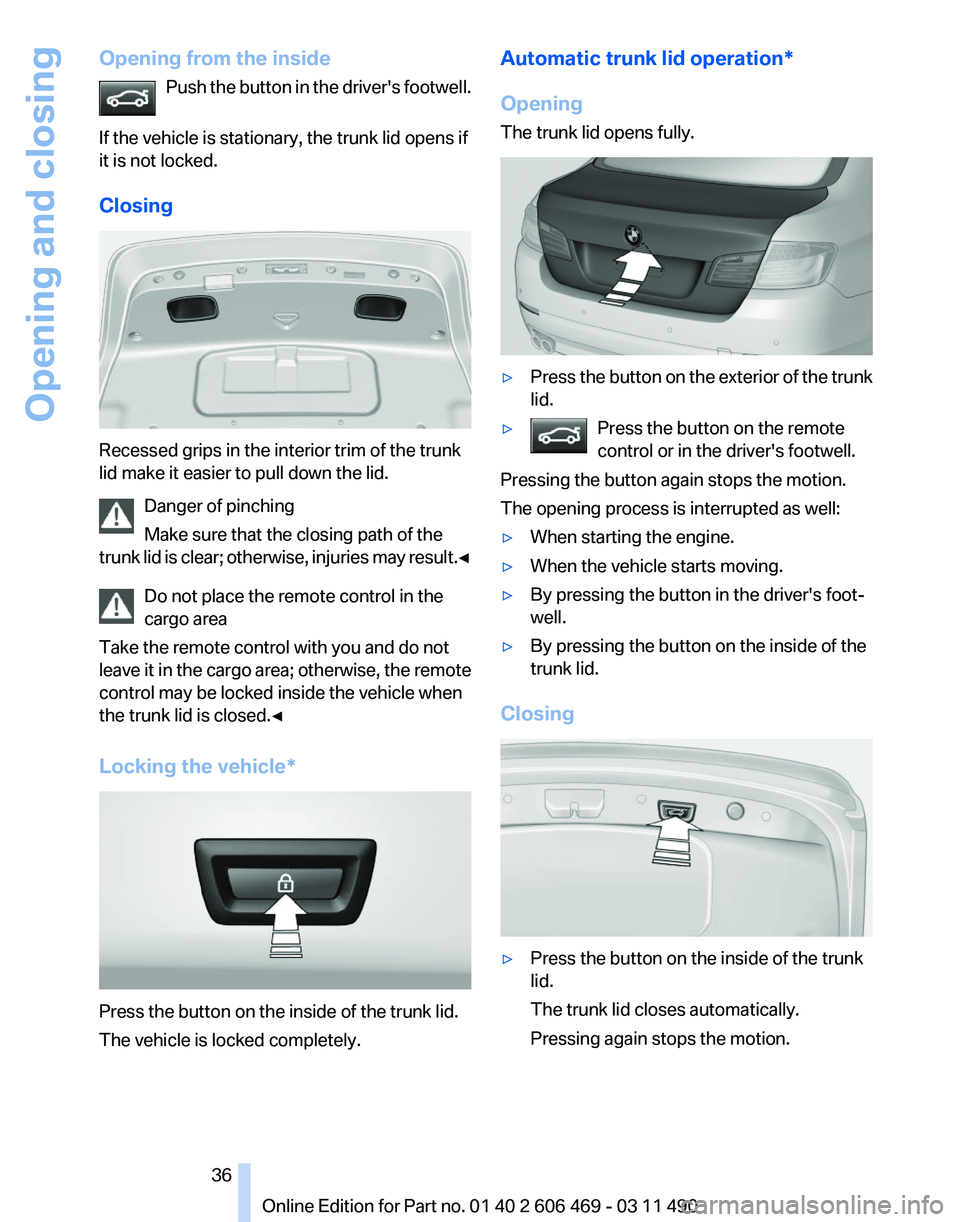
Opening from the inside
Push the button in the driver's footwell.
If the vehicle is stationary, the trunk lid opens if
it is not locked.
Closing Recessed grips in the interior trim of the trunk
lid make it easier to pull down the lid.
Danger of pinching
Make sure that the closing path of the
trunk
lid is clear; otherwise, injuries may result.‚óÄDo not place the remote control in the
cargo area
Take the remote control with you and do not
leave it in the cargo area; otherwise, the remote
control may be locked inside the vehicle when
the trunk lid is closed.‚óÄ
Locking the vehicle* Press the button on the inside of the trunk lid.
The vehicle is locked completely. Automatic trunk lid operation*
Opening
The trunk lid opens fully.
‚ñ∑
Press the button on the exterior of the trunk
lid.
‚ñ∑ Press the button on the remote
control or in the driver's footwell. Pressing the button again stops the motion.
The opening process is interrupted as well:
‚ñ∑
When starting the engine.
‚ñ∑ When the vehicle starts moving.
‚ñ∑ By pressing the button in the driver's foot‚Äê
well.
‚ñ∑ By pressing the button on the inside of the
trunk lid.
Closing ‚ñ∑
Press the button on the inside of the trunk
lid.
The trunk lid closes automatically.
Pressing again stops the motion.
Seite 36
36 Online Edition for Part no. 01 40 2 606 469 - 03 11 490
Opening and closing
Page 37 of 304
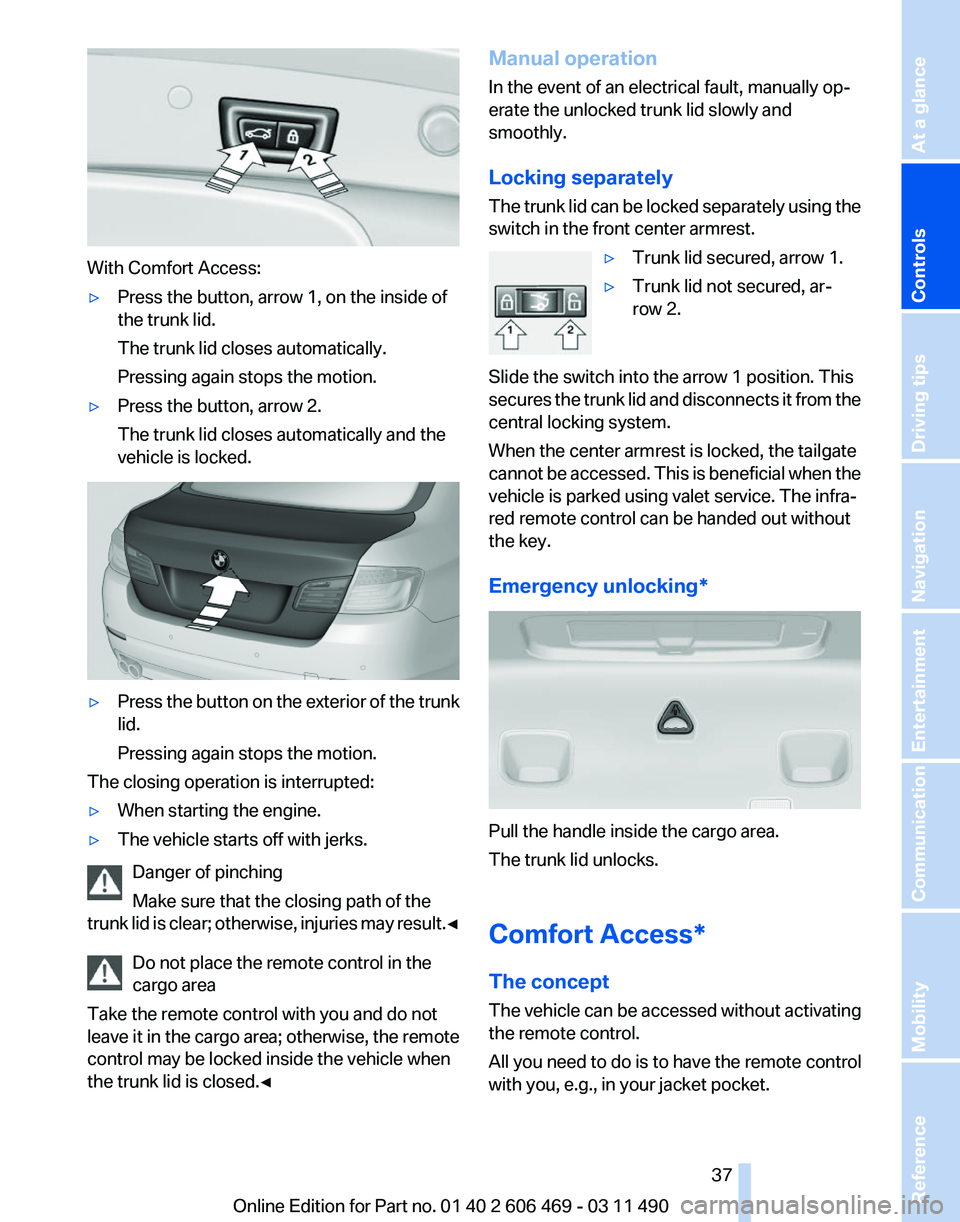
With Comfort Access:
‚ñ∑
Press the button, arrow 1, on the inside of
the trunk lid.
The trunk lid closes automatically.
Pressing again stops the motion.
‚ñ∑ Press the button, arrow 2.
The trunk lid closes automatically and the
vehicle is locked. ‚ñ∑
Press the button on the exterior of the trunk
lid.
Pressing again stops the motion.
The closing operation is interrupted:
‚ñ∑ When starting the engine.
‚ñ∑ The vehicle starts off with jerks.
Danger of pinching
Make sure that the closing path of the
trunk
lid is clear; otherwise, injuries may result.‚óÄ Do not place the remote control in the
cargo area
Take the remote control with you and do not
leave it in the cargo area; otherwise, the remote
control may be locked inside the vehicle when
the trunk lid is closed.‚óÄ Manual operation
In the event of an electrical fault, manually op‚Äê
erate the unlocked trunk lid slowly and
smoothly.
Locking separately
The
trunk lid can be locked separately using the
switch in the front center armrest.
‚ñ∑Trunk lid secured, arrow 1.
‚ñ∑ Trunk lid not secured, ar‚Äê
row 2.
Slide the switch into the arrow 1 position. This
secures
the trunk lid and disconnects it from the
central locking system.
When the center armrest is locked, the tailgate
cannot be accessed. This is beneficial when the
vehicle is parked using valet service. The infra‚Äê
red remote control can be handed out without
the key.
Emergency unlocking* Pull the handle inside the cargo area.
The trunk lid unlocks.
Comfort Access*
The concept
The vehicle can be accessed without activating
the remote control.
All you need to do is to have the remote control
with you, e.g., in your jacket pocket. Seite 37
37Online Edition for Part no. 01 40 2 606 469 - 03 11 490
Reference Mobility Communication Entertainment Navigation Driving tips
Controls At a glance
Page 38 of 304
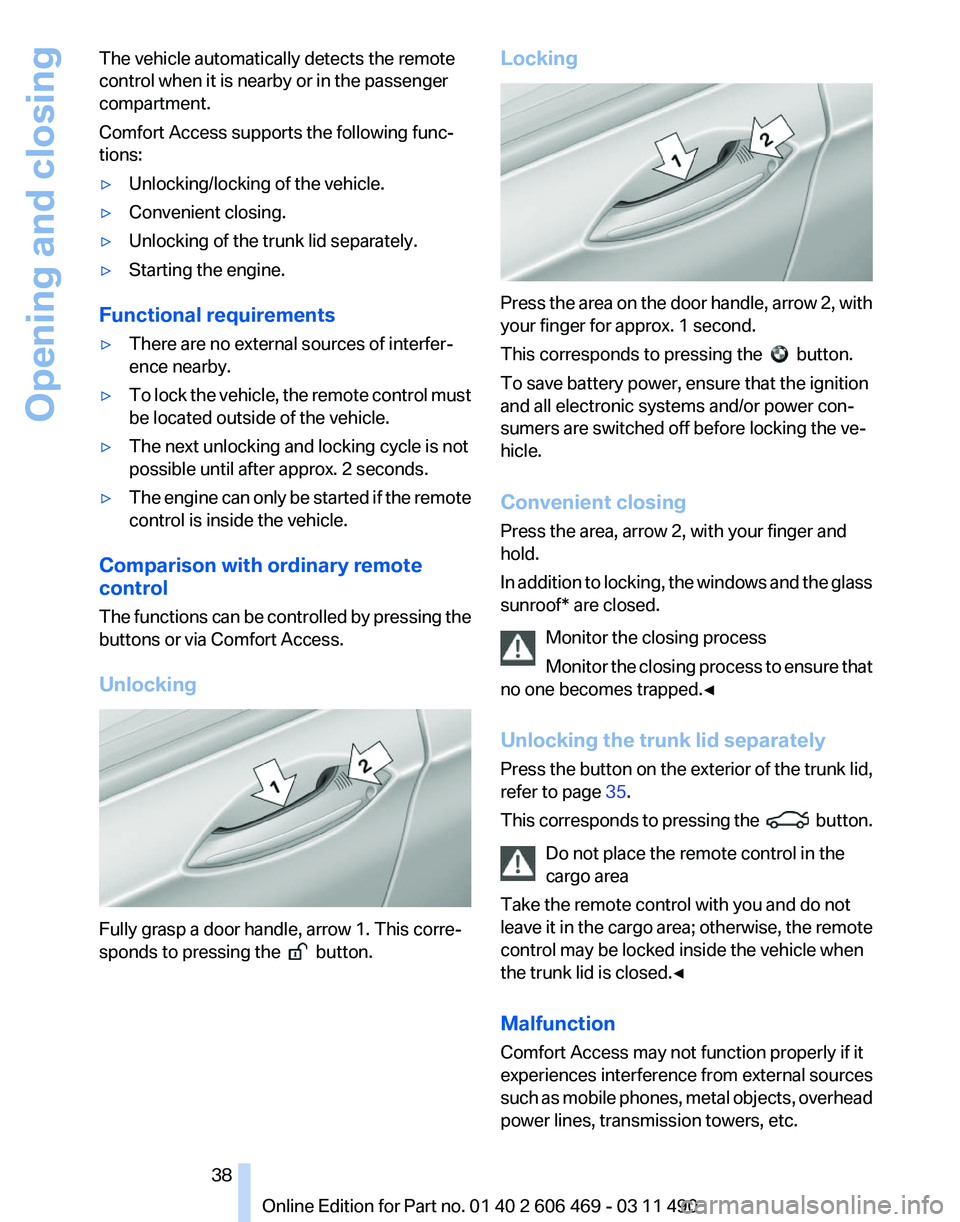
The vehicle automatically detects the remote
control when it is nearby or in the passenger
compartment.
Comfort Access supports the following func‚Äê
tions:
‚ñ∑
Unlocking/locking of the vehicle.
‚ñ∑ Convenient closing.
‚ñ∑ Unlocking of the trunk lid separately.
‚ñ∑ Starting the engine.
Functional requirements
‚ñ∑ There are no external sources of interfer‚Äê
ence nearby.
‚ñ∑ To lock the vehicle, the remote control must
be located outside of the vehicle.
‚ñ∑ The next unlocking and locking cycle is not
possible until after approx. 2 seconds.
‚ñ∑ The engine can only be started if the remote
control is inside the vehicle.
Comparison with ordinary remote
control
The
functions can be controlled by pressing the
buttons or via Comfort Access.
Unlocking Fully grasp a door handle, arrow 1. This corre‚Äê
sponds to pressing the
button.Locking Press the area on the door handle, arrow 2, with
your finger for approx. 1 second.
This corresponds to pressing the
button.
To save battery power, ensure that the ignition
and all electronic systems and/or power con‚Äê
sumers are switched off before locking the ve‚Äê
hicle.
Convenient closing
Press the area, arrow 2, with your finger and
hold.
In
addition to locking, the windows and the glass
sunroof* are closed.
Monitor the closing process
Monitor the closing process to ensure that
no one becomes trapped.‚óÄ
Unlocking the trunk lid separately
Press the button on the exterior of the trunk lid,
refer to page 35.
This corresponds to pressing the button.
Do not place the remote control in the
cargo area
Take the remote control with you and do not
leave
it in the cargo area; otherwise, the remote
control may be locked inside the vehicle when
the trunk lid is closed.‚óÄ
Malfunction
Comfort Access may not function properly if it
experiences interference from external sources
such as mobile phones, metal objects, overhead
power lines, transmission towers, etc. Seite 38
38 Online Edition for Part no. 01 40 2 606 469 - 03 11 490
Opening and closing
Page 39 of 304
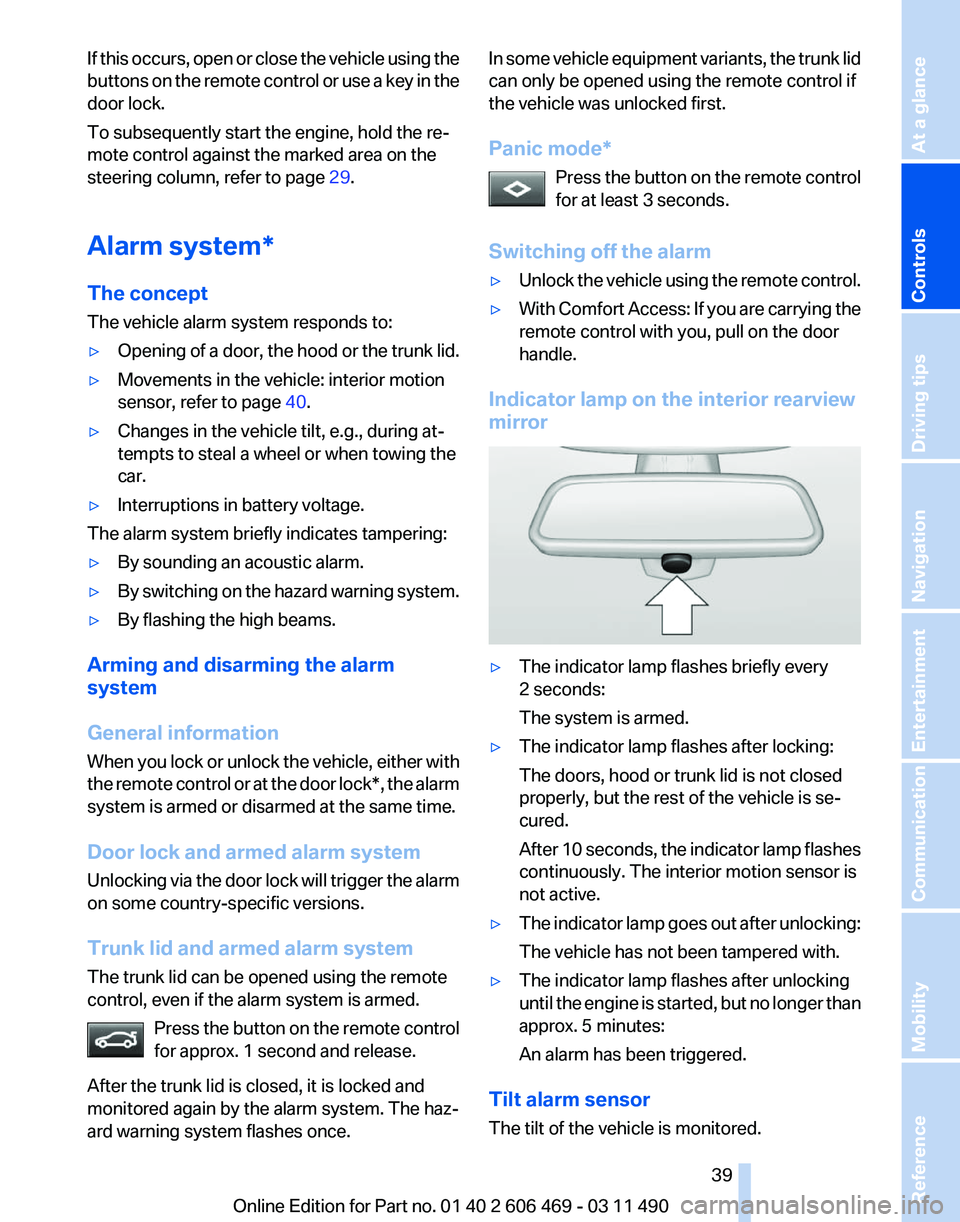
If this occurs, open or close the vehicle using the
buttons
on the remote control or use a key in the
door lock.
To subsequently start the engine, hold the re‚Äê
mote control against the marked area on the
steering column, refer to page 29.
Alarm system*
The concept
The vehicle alarm system responds to:
‚ñ∑ Opening of a door, the hood or the trunk lid.
‚ñ∑ Movements in the vehicle: interior motion
sensor, refer to page 40.
‚ñ∑ Changes in the vehicle tilt, e.g., during at‚Äê
tempts to steal a wheel or when towing the
car.
‚ñ∑ Interruptions in battery voltage.
The alarm system briefly indicates tampering:
‚ñ∑ By sounding an acoustic alarm.
‚ñ∑ By switching on the hazard warning system.
‚ñ∑ By flashing the high beams.
Arming and disarming the alarm
system
General information
When
you lock or unlock the vehicle, either with
the remote control or at the door lock*, the alarm
system is armed or disarmed at the same time.
Door lock and armed alarm system
Unlocking via the door lock will trigger the alarm
on some country-specific versions.
Trunk lid and armed alarm system
The trunk lid can be opened using the remote
control, even if the alarm system is armed.
Press the button on the remote control
for approx. 1 second and release.
After the trunk lid is closed, it is locked and
monitored again by the alarm system. The haz‚Äê
ard warning system flashes once. In some vehicle equipment variants, the trunk lid
can only be opened using the remote control if
the vehicle was unlocked first.
Panic mode*
Press
the button on the remote control
for at least 3 seconds.
Switching off the alarm
‚ñ∑ Unlock the vehicle using the remote control.
‚ñ∑ With Comfort Access: If you are carrying the
remote control with you, pull on the door
handle.
Indicator lamp on the interior rearview
mirror ‚ñ∑
The indicator lamp flashes briefly every
2 seconds:
The system is armed.
‚ñ∑ The indicator lamp flashes after locking:
The doors, hood or trunk lid is not closed
properly, but the rest of the vehicle is se‚Äê
cured.
After
10 seconds, the indicator lamp flashes
continuously. The interior motion sensor is
not active.
‚ñ∑ The indicator lamp goes out after unlocking:
The vehicle has not been tampered with.
‚ñ∑ The indicator lamp flashes after unlocking
until
the engine is started, but no longer than
approx. 5 minutes:
An alarm has been triggered.
Tilt alarm sensor
The tilt of the vehicle is monitored. Seite 39
39Online Edition for Part no. 01 40 2 606 469 - 03 11 490
Reference Mobility Communication Entertainment Navigation Driving tips
Controls At a glance
Page 40 of 304
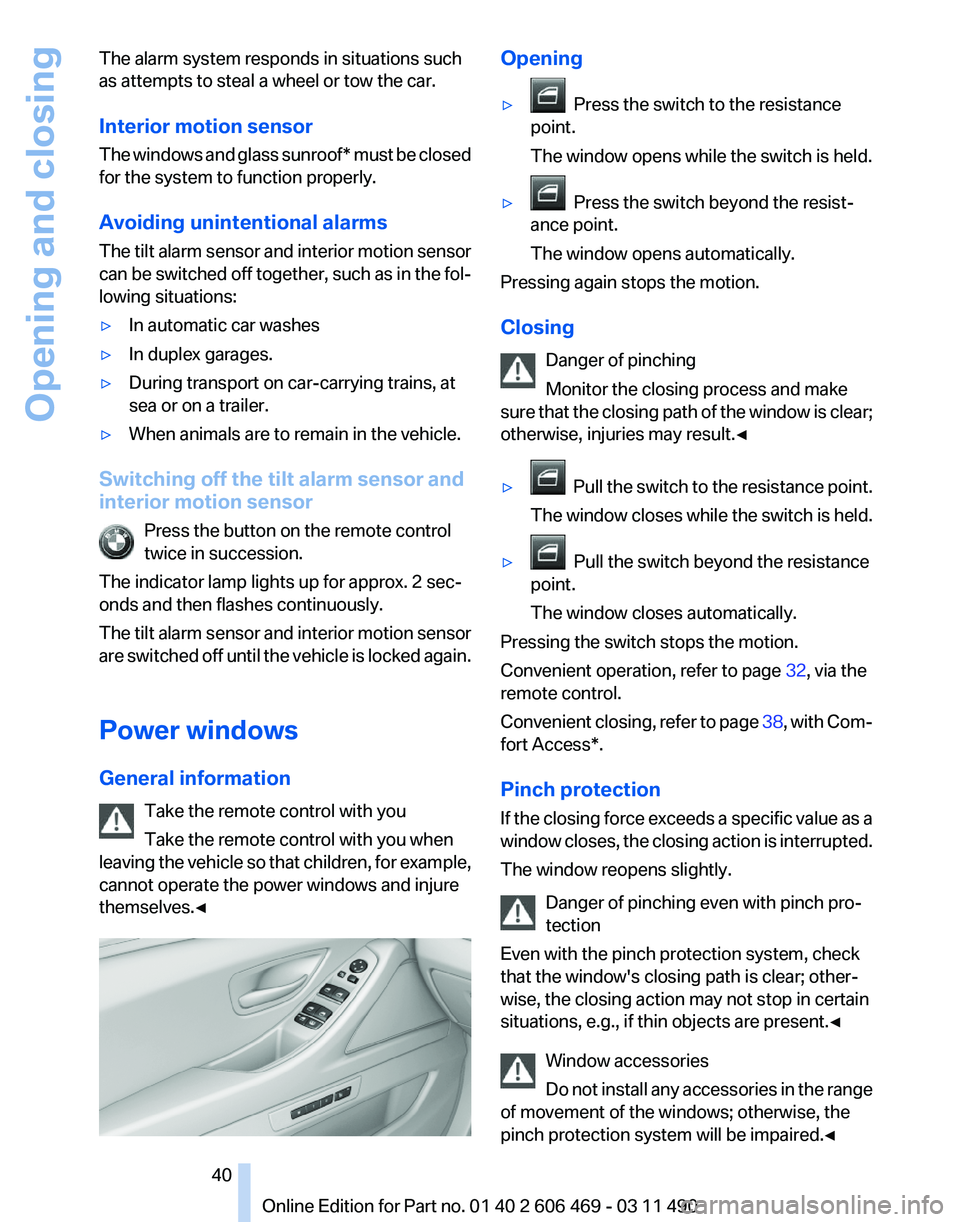
The alarm system responds in situations such
as attempts to steal a wheel or tow the car.
Interior motion sensor
The
windows and glass sunroof* must be closed
for the system to function properly.
Avoiding unintentional alarms
The tilt alarm sensor and interior motion sensor
can be switched off together, such as in the fol‚Äê
lowing situations:
‚ñ∑ In automatic car washes
‚ñ∑ In duplex garages.
‚ñ∑ During transport on car-carrying trains, at
sea or on a trailer.
‚ñ∑ When animals are to remain in the vehicle.
Switching off the tilt alarm sensor and
interior motion sensor Press the button on the remote control
twice in succession.
The indicator lamp lights up for approx. 2 sec‚Äê
onds and then flashes continuously.
The
tilt alarm sensor and interior motion sensor
are switched off until the vehicle is locked again.
Power windows
General information
Take the remote control with you
Take the remote control with you when
leaving the vehicle so that children, for example,
cannot operate the power windows and injure
themselves.‚óÄ Opening
‚ñ∑
Press the switch to the resistance
point.
The window opens while the switch is held.
‚ñ∑ Press the switch beyond the resist‚Äê
ance point.
The window opens automatically.
Pressing again stops the motion.
Closing
Danger of pinching
Monitor the closing process and make
sure
that the closing path of the window is clear;
otherwise, injuries may result.‚óÄ
‚ñ∑ Pull
the switch to the resistance point.
The window closes while the switch is held.
‚ñ∑ Pull the switch beyond the resistance
point.
The window closes automatically.
Pressing the switch stops the motion.
Convenient operation, refer to page 32, via the
remote control.
Convenient
closing, refer to page 38, with Com‚Äê
fort Access*.
Pinch protection
If the closing force exceeds a specific value as a
window closes, the closing action is interrupted.
The window reopens slightly.
Danger of pinching even with pinch pro‚Äê
tection
Even with the pinch protection system, check
that the window's closing path is clear; other‚Äê
wise, the closing action may not stop in certain
situations, e.g., if thin objects are present.‚óÄ
Window accessories
Do not install any accessories in the range
of movement of the windows; otherwise, the
pinch protection system will be impaired.‚óÄ Seite 40
40 Online Edition for Part no. 01 40 2 606 469 - 03 11 490
Opening and closing
Page 41 of 304
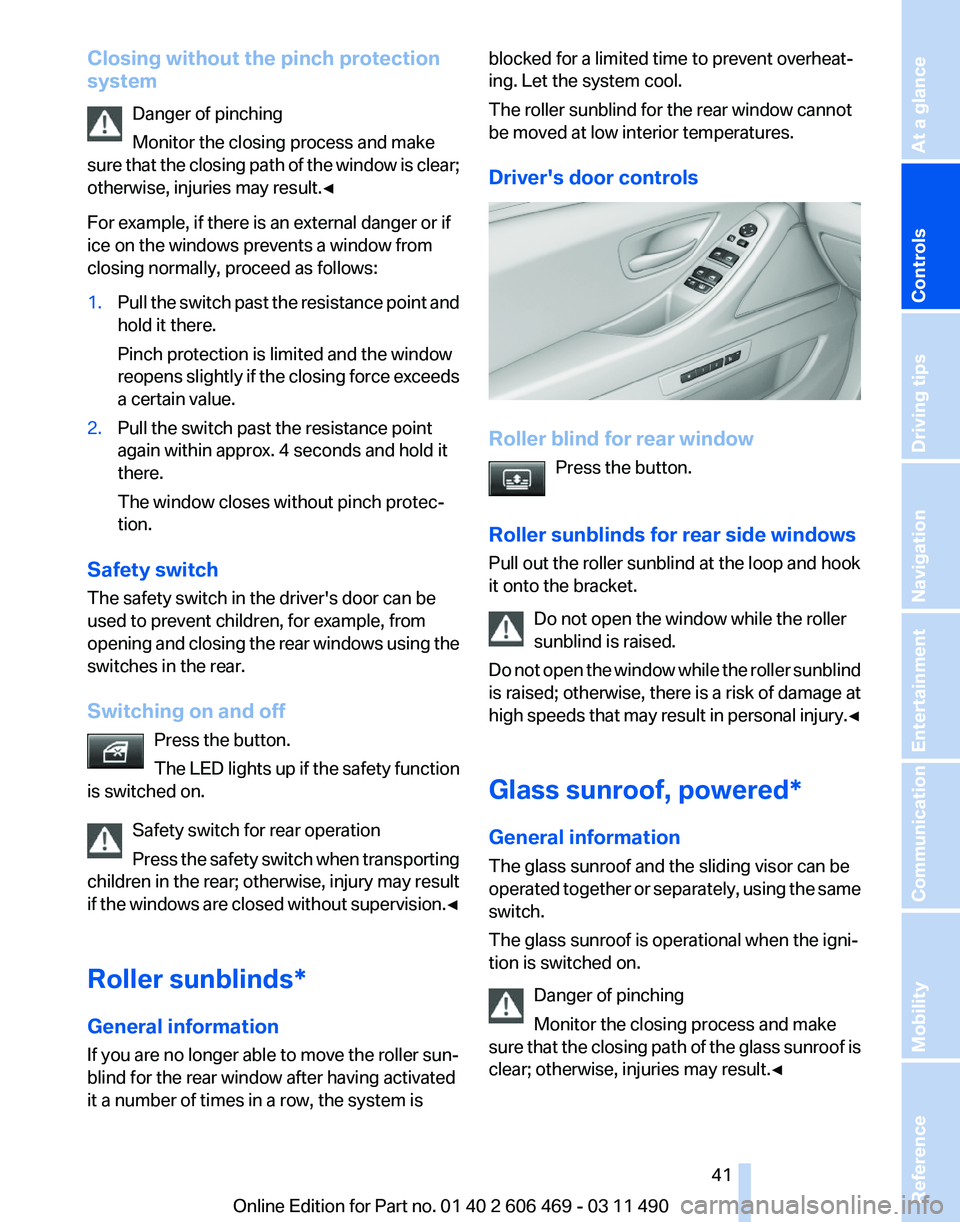
Closing without the pinch protection
system
Danger of pinching
Monitor the closing process and make
sure
that the closing path of the window is clear;
otherwise, injuries may result.‚óÄ
For example, if there is an external danger or if
ice on the windows prevents a window from
closing normally, proceed as follows:
1. Pull the switch past the resistance point and
hold it there.
Pinch protection is limited and the window
reopens
slightly if the closing force exceeds
a certain value.
2. Pull the switch past the resistance point
again within approx. 4 seconds and hold it
there.
The window closes without pinch protec‚Äê
tion.
Safety switch
The safety switch in the driver's door can be
used to prevent children, for example, from
opening
and closing the rear windows using the
switches in the rear.
Switching on and off
Press the button.
The LED lights up if the safety function
is switched on.
Safety switch for rear operation
Press the safety switch when transporting
children in the rear; otherwise, injury may result
if the windows are closed without supervision.‚óÄ
Roller sunblinds*
General information
If you are no longer able to move the roller sun‚Äê
blind for the rear window after having activated
it a number of times in a row, the system is blocked for a limited time to prevent overheat‚Äê
ing. Let the system cool.
The roller sunblind for the rear window cannot
be moved at low interior temperatures.
Driver's door controls
Roller blind for rear window
Press the button.
Roller sunblinds for rear side windows
Pull out the roller sunblind at the loop and hook
it onto the bracket. Do not open the window while the roller
sunblind is raised.
Do
not open the window while the roller sunblind
is raised; otherwise, there is a risk of damage at
high speeds that may result in personal injury.‚óÄ
Glass sunroof, powered*
General information
The glass sunroof and the sliding visor can be
operated together or separately, using the same
switch.
The glass sunroof is operational when the igni‚Äê
tion is switched on.
Danger of pinching
Monitor the closing process and make
sure that the closing path of the glass sunroof is
clear; otherwise, injuries may result.‚óÄ Seite 41
41Online Edition for Part no. 01 40 2 606 469 - 03 11 490
Reference Mobility Communication Entertainment Navigation Driving tips
Controls At a glance
Page 44 of 304
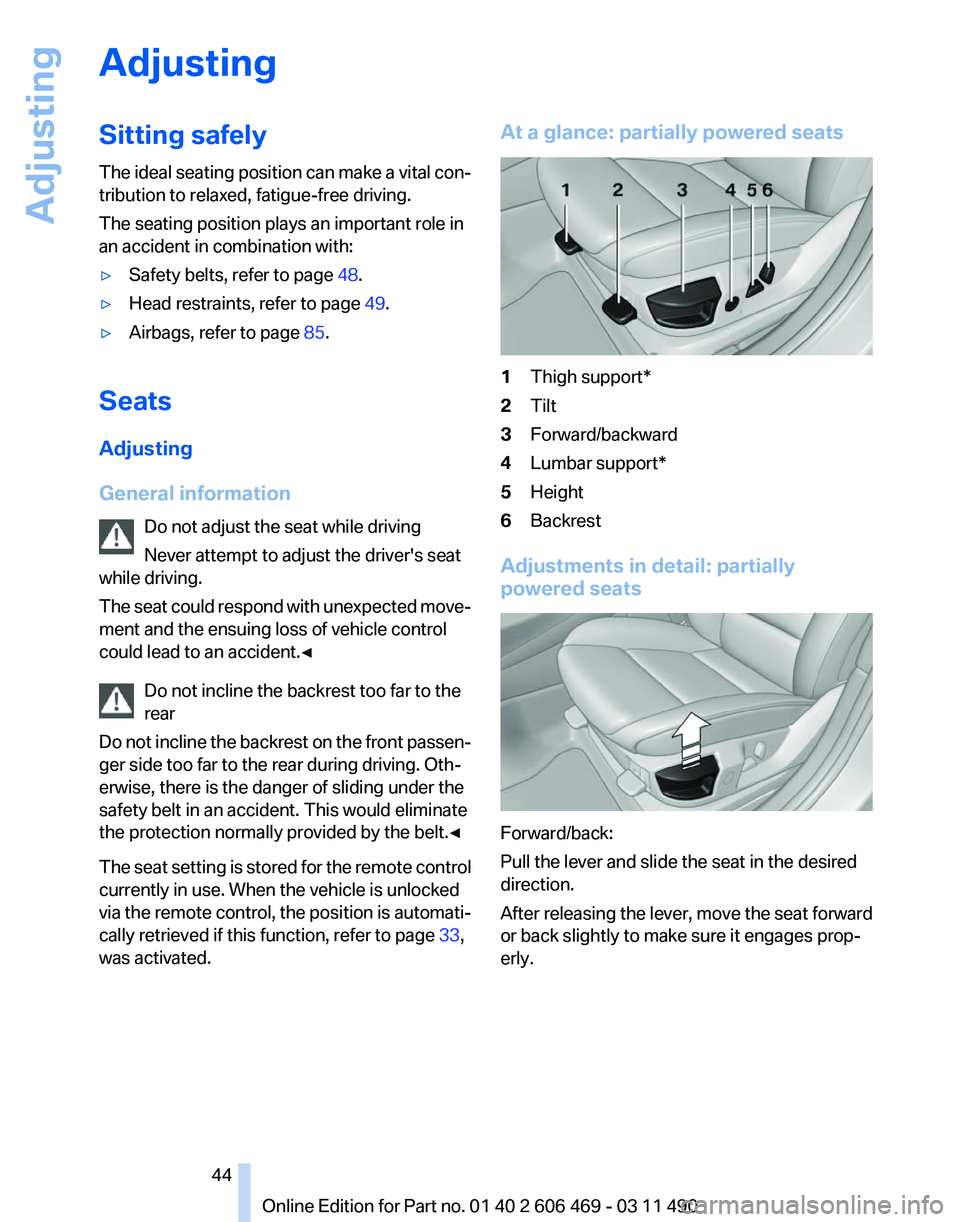
Adjusting
Sitting safely
The
ideal seating position can make a vital con‚Äê
tribution to relaxed, fatigue-free driving.
The seating position plays an important role in
an accident in combination with:
‚ñ∑ Safety belts, refer to page 48.
‚ñ∑ Head restraints, refer to page 49.
‚ñ∑ Airbags, refer to page 85.
Seats
Adjusting
General information Do not adjust the seat while driving
Never attempt to adjust the driver's seat
while driving.
The
seat could respond with unexpected move‚Äê
ment and the ensuing loss of vehicle control
could lead to an accident.‚óÄ
Do not incline the backrest too far to the
rear
Do not incline the backrest on the front passen‚Äê
ger side too far to the rear during driving. Oth‚Äê
erwise, there is the danger of sliding under the
safety belt in an accident. This would eliminate
the protection normally provided by the belt.‚óÄ
The seat setting is stored for the remote control
currently in use. When the vehicle is unlocked
via the remote control, the position is automati‚Äê
cally retrieved if this function, refer to page 33,
was activated. At a glance: partially powered seats
1
Thigh support*
2 Tilt
3 Forward/backward
4 Lumbar support*
5 Height
6 Backrest
Adjustments in detail: partially
powered seats Forward/back:
Pull the lever and slide the seat in the desired
direction.
After
releasing the lever, move the seat forward
or back slightly to make sure it engages prop‚Äê
erly.
Seite 44
44 Online Edition for Part no. 01 40 2 606 469 - 03 11 490
Adjusting
Page 52 of 304
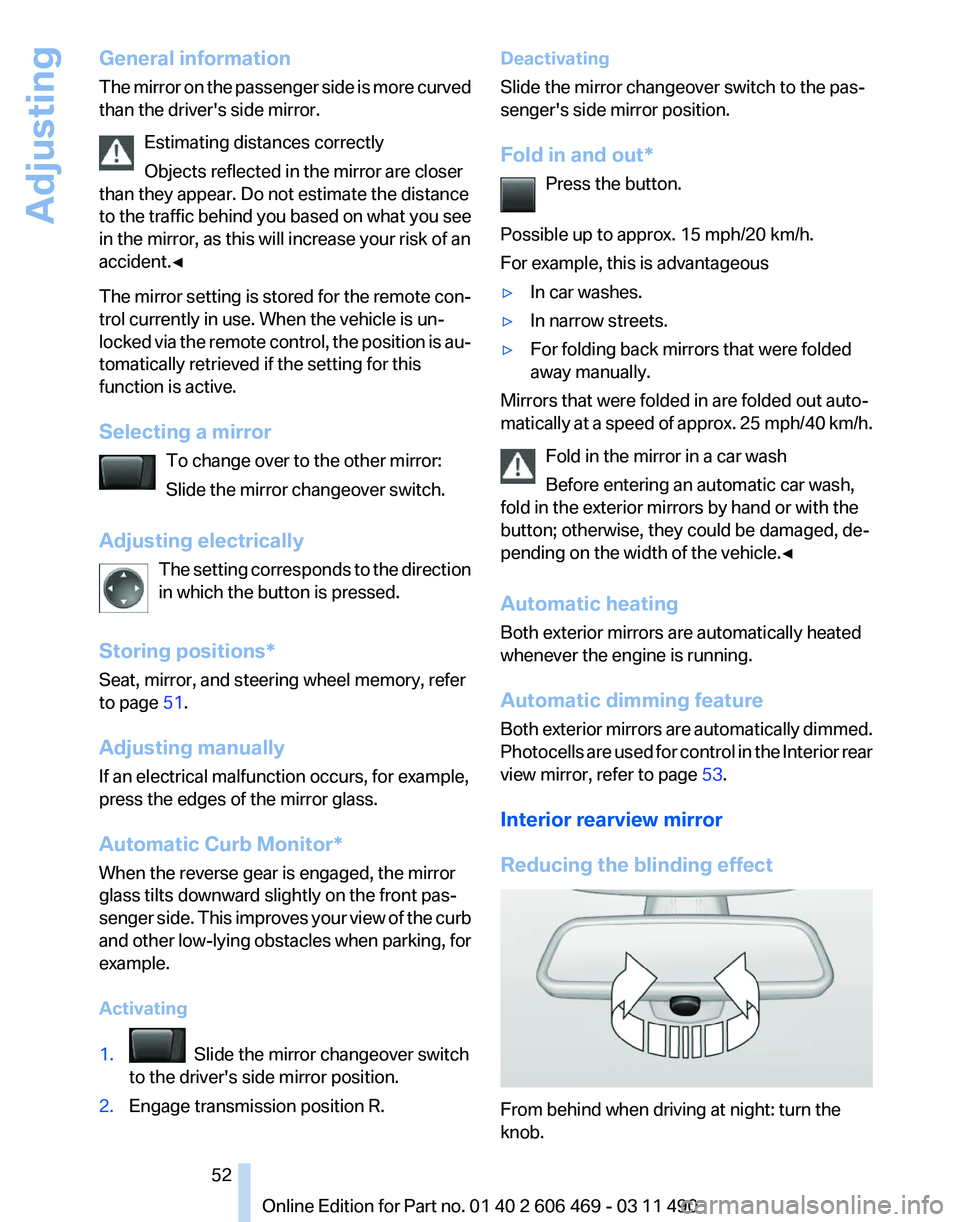
General information
The
mirror on the passenger side is more curved
than the driver's side mirror.
Estimating distances correctly
Objects reflected in the mirror are closer
than they appear. Do not estimate the distance
to the traffic behind you based on what you see
in the mirror, as this will increase your risk of an
accident.‚óÄ
The mirror setting is stored for the remote con‚Äê
trol currently in use. When the vehicle is un‚Äê
locked via the remote control, the position is au‚Äê
tomatically retrieved if the setting for this
function is active.
Selecting a mirror
To change over to the other mirror:
Slide the mirror changeover switch.
Adjusting electrically The setting corresponds to the direction
in which the button is pressed.
Storing positions*
Seat, mirror, and steering wheel memory, refer
to page 51.
Adjusting manually
If an electrical malfunction occurs, for example,
press the edges of the mirror glass.
Automatic Curb Monitor*
When the reverse gear is engaged, the mirror
glass tilts downward slightly on the front pas‚Äê
senger side. This improves your view of the curb
and other low-lying obstacles when parking, for
example.
Activating
1. Slide the mirror changeover switch
to the driver's side mirror position.
2. Engage transmission position R. Deactivating
Slide the mirror changeover switch to the pas‚Äê
senger's side mirror position.
Fold in and out*
Press the button.
Possible up to approx. 15 mph/20 km/h.
For example, this is advantageous
‚ñ∑ In car washes.
‚ñ∑ In narrow streets.
‚ñ∑ For folding back mirrors that were folded
away manually.
Mirrors that were folded in are folded out auto‚Äê
matically
at a speed of approx. 25 mph/40 km/h.
Fold in the mirror in a car wash
Before entering an automatic car wash,
fold in the exterior mirrors by hand or with the
button; otherwise, they could be damaged, de‚Äê
pending on the width of the vehicle.‚óÄ
Automatic heating
Both exterior mirrors are automatically heated
whenever the engine is running.
Automatic dimming feature
Both exterior mirrors are automatically dimmed.
Photocells are used for control in the Interior rear
view mirror, refer to page 53.
Interior rearview mirror
Reducing the blinding effect From behind when driving at night: turn the
knob. Seite 52
52 Online Edition for Part no. 01 40 2 606 469 - 03 11 490
Adjusting
Page 55 of 304
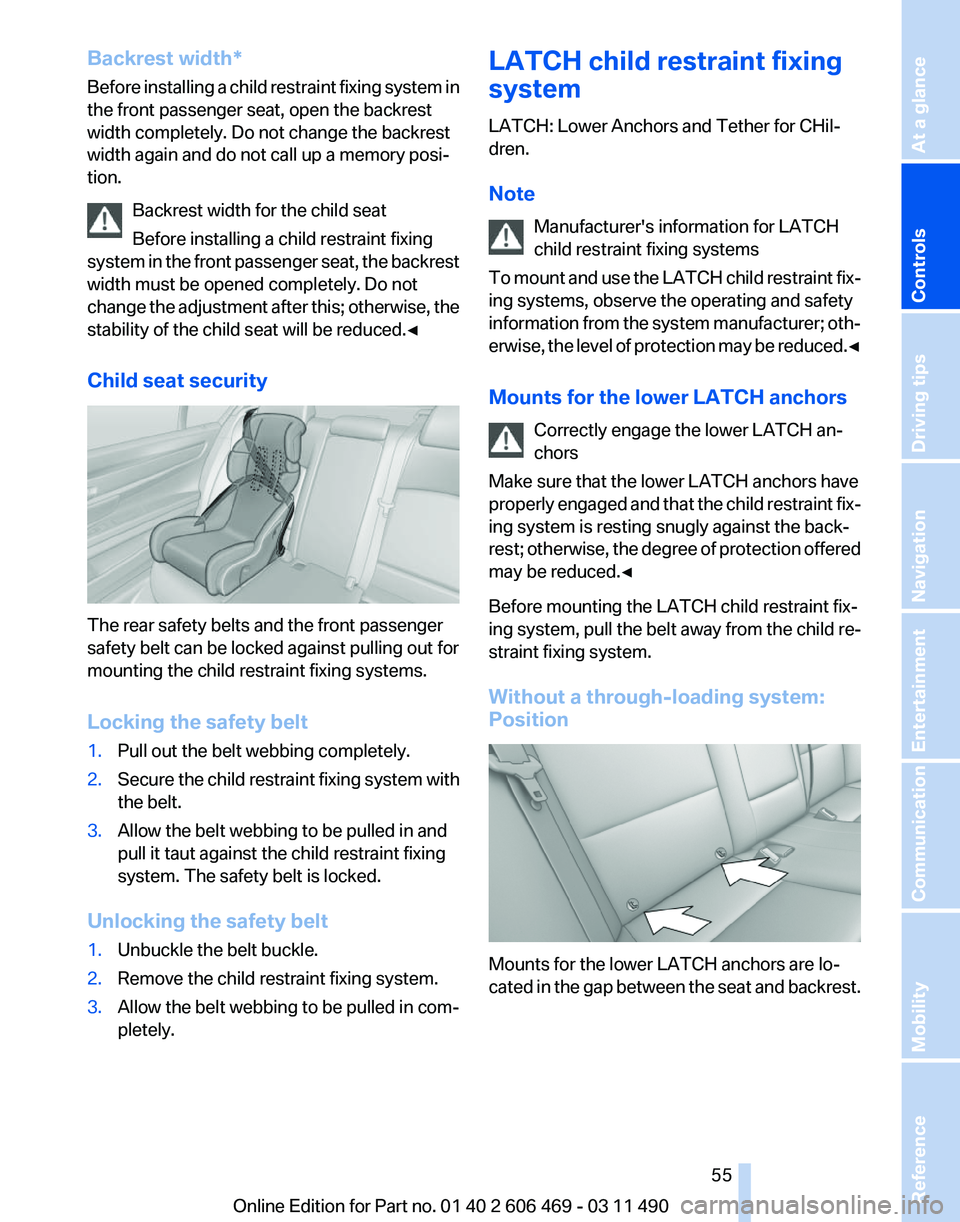
Backrest width*
Before
installing a child restraint fixing system in
the front passenger seat, open the backrest
width completely. Do not change the backrest
width again and do not call up a memory posi‚Äê
tion.
Backrest width for the child seat
Before installing a child restraint fixing
system in the front passenger seat, the backrest
width must be opened completely. Do not
change the adjustment after this; otherwise, the
stability of the child seat will be reduced.‚óÄ
Child seat security The rear safety belts and the front passenger
safety belt can be locked against pulling out for
mounting the child restraint fixing systems.
Locking the safety belt
1.
Pull out the belt webbing completely.
2. Secure the child restraint fixing system with
the belt.
3. Allow the belt webbing to be pulled in and
pull it taut against the child restraint fixing
system. The safety belt is locked.
Unlocking the safety belt
1. Unbuckle the belt buckle.
2. Remove the child restraint fixing system.
3. Allow the belt webbing to be pulled in com‚Äê
pletely. LATCH child restraint fixing
system
LATCH: Lower Anchors and Tether for CHil‚Äê
dren.
Note
Manufacturer's information for LATCH
child restraint fixing systems
To
mount and use the LATCH child restraint fix‚Äê
ing systems, observe the operating and safety
information from the system manufacturer; oth‚Äê
erwise, the level of protection may be reduced.‚óÄ
Mounts for the lower LATCH anchors
Correctly engage the lower LATCH an‚Äê
chors
Make sure that the lower LATCH anchors have
properly engaged and that the child restraint fix‚Äê
ing system is resting snugly against the back‚Äê
rest; otherwise, the degree of protection offered
may be reduced.‚óÄ
Before mounting the LATCH child restraint fix‚Äê
ing system, pull the belt away from the child re‚Äê
straint fixing system.
Without a through-loading system:
Position Mounts for the lower LATCH anchors are lo‚Äê
cated
in the gap between the seat and backrest. Seite 55
55Online Edition for Part no. 01 40 2 606 469 - 03 11 490
Reference Mobility Communication Entertainment Navigation Driving tips
Controls At a glance